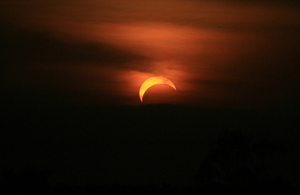Don’t let your eyes take the strain in the eclipse
Think about how to view the eclipse safely before you enjoy the spectacle.

Partial solar eclipse
Public Health England (PHE) is reminding people planning to watch the partial eclipse of the sun on Friday 20 March 2015 to take precautions to reduce potential damage to their eyes.
The eclipse will be visible across the country, with observers in Scotland likely to see more of the sun obscured by the moon than any other part of the UK.
John O’Hagan, head of the optical radiation group at PHE, said:
An eclipse is an amazing spectacle and one which we expect people all over the UK to enjoy.
But it’s important to remember that this amazing sight, if viewed incorrectly, could pose a risk to your eyesight. Even if it’s cloudy there’s a risk of eye damage. Sunglasses won’t give enough protection. Although they may reduce the sun’s glare, they allow you to look for longer, allowing more sunlight into the eye.
The Royal Astronomical Society (RAS) has published detailed advice and useful information on how to safely view the eclipse. They advise that viewing a solar eclipse is potentially hazardous and should only be attempted with caution. You should never, ever – under any circumstances – look directly at the Sun. In their leaflet they list there are things we can get hold of easily – or even make – that are safe to use.
The UK last experienced a total eclipse of the sun in August 1999. In 2000 the journal of the Royal College of Opthalmologists published a study detailing the health effects of the event the previous August. Approximately 70 people reported a loss of vision, with half of that total reporting issues within 48 hours, as a consequence of gazing at the eclipse. Of those more than half used no eye protection and 30% used some kind of filter, such as sunglasses, which did not have the desired protective effect. Forty percent of those that reported injury had looked at the eclipse for less than a minute.
The reason the eclipse poses a risk to eyes is that most of the time the sun is too bright for us to look directly at it. In an eclipse strong sunlight penetrates into our eyes and the retina can be damaged, without the feeling of pain.
Dr O’Hagan added:
There’s lots of ways you can safely enjoy the eclipse, using a pinhole viewer, mirrors or even with a colander and a sheet of paper. But it’s really important you do it right, to minimise any risk to your eyes, so do investigate the RAS leaflet as it describes well what to do to protect your eyes.
Photo by davidfntau. Used under Flickr Creative Commons.